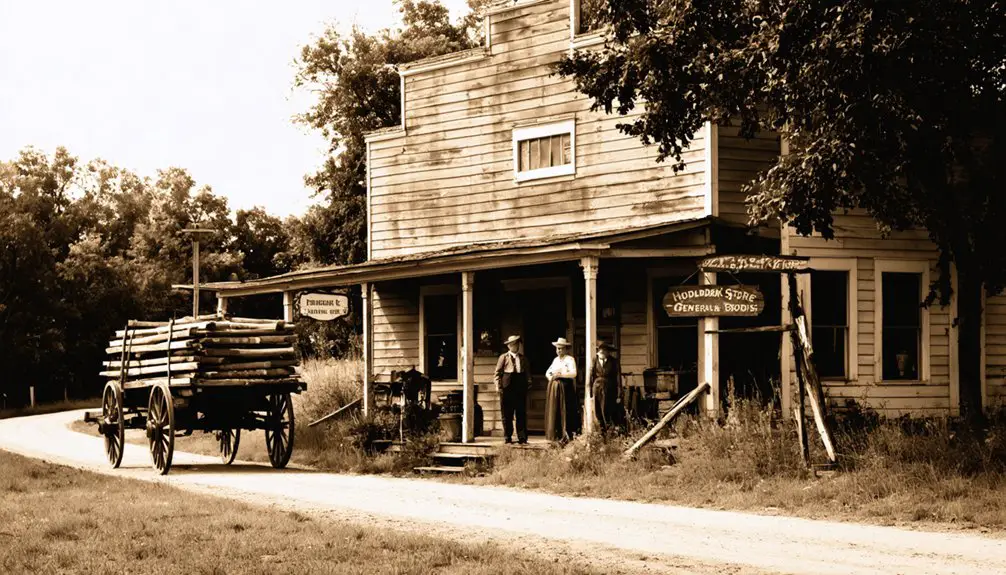You’ll find Federman’s remains in Monroe County, Michigan, where it emerged as an essential railroad crossing in 1878 between the Ann Arbor Railroad and New York Central’s Monroe Branch. The town featured a manual ground interlocking system, post office (1899-1906), and general store serving railroad workers. Though it thrived briefly as a transportation hub, Federman declined in the 1920s and ceased operations by 1971. Its story reveals fascinating insights about Michigan’s vanished railroad communities.
Key Takeaways
- Federman was established in 1884 as a railroad junction town where Ann Arbor Railroad crossed New York Central’s Monroe Branch.
- The town primarily served as a railroad community with transient workers, limiting its development into a permanent residential settlement.
- A post office operated from 1899 to 1906, marking the town’s brief period of growth before its gradual decline.
- Economic decline began in the 1920s, with complete abandonment of services by 1971, transforming Federman into a ghost town.
- Archaeological remnants include parts of the 1903 interlocking machine and railroad equipment, but few structural remains exist today.
The Birth of a Railroad Junction
While many Michigan railroad junctions emerged during the late 1800s, Federman began as a crucial grade crossing between the Ann Arbor Railroad’s main line and the New York Central’s Monroe Branch. With regular service beginning in June 21, 1878, the junction quickly became an important transit point.
Train crews operated the controls from a small 12×12-foot shanty, housing a 10-lever “armstrong” machine that managed crossing movements. This essential operational node linked Toledo-to-Frankfort traffic with the Monroe Branch’s local service, establishing Federman as a fundamental piece in Michigan’s expanding rail network.
You’ll find that railroad technology at this strategic junction featured a manual ground interlocking system, installed in 1903 with a Saxby-Farmer lever machine from US&S Co. The junction’s significance centered on its ability to efficiently connect east-west and north-south rail traffic across Monroe County. The local depot stayed operational until the 1950s, serving passengers along this vital transportation corridor.
Railroad Infrastructure and Operations
As trains rumbled through Federman’s critical junction point, they relied on a sophisticated manual ground interlocking system to safely navigate the crossing between the Ann Arbor Railroad’s main line and the New York Central’s Monroe Branch.
Railroad technology at Federman centered around a 10-lever Saxby-Farmer “Armstrong” machine, manufactured by US&S Company in 1903.
You’ll find these fascinating aspects of Federman’s interlocking systems:
- A compact 12×12-foot shanty housed the essential control equipment
- Train crews from New York Central (later Conrail) operated the levers themselves
- The system coordinated both freight and passenger services until the 1950s
- The manual interlocking remained active through most of the 20th century
The junction’s careful operation demonstrated how railroad crews managed complex rail intersections with purely mechanical controls. These mechanical systems were a vast improvement over the earlier strap rails that had been completely removed from Michigan’s railroads by 1852. The state’s transition to private investment in 1846 brought crucial improvements when the legislature sold the rail lines to private investors.
Post Office Era: 1899-1906
The Federman post office, established in 1899 at the junction of Lake Shore and Michigan Southern Railroad and Toledo, Ann Arbor and Northern Michigan Railroad, served as your primary mail hub if you lived in this small Monroe County community.
Similar to Ocqueoc’s postal operation era, the postmaster likely managed multiple duties to serve the small population.
Like many entries on the surname disambiguation page, this town carried the Federman family name and required clear identification to avoid confusion with other references.
You’d find the post office operating in conjunction with the railroad station, facilitating communication for both railway workers and local residents during the town’s peak period.
Your ability to send and receive mail through this essential service lasted until 1906, when the post office’s closure signaled the beginning of Federman’s decline toward ghost town status.
Mail Service Operations
During Federman’s brief but important postal era from 1899 to 1906, mail service operations centered around the railroad junction in Monroe County, Michigan.
You’d find mail delivery happening through a crucial intersection of the Lake Shore and Michigan Southern and Toledo, Ann Arbor and Northern Michigan railroads.
The postal challenges facing Federman’s operations included:
- Manual sorting of mail in multi-use buildings, often sharing space with general stores
- Coordination with fluctuating railroad schedules for mail dispatch and receipt
- Management of expanding rural free delivery routes and steel mailbox installations
- Balancing efficient service with modest mail volumes typical of small communities
Staff duties involved precise timing with trains, careful sorting, and maintaining consistent service despite the era’s limited infrastructure and rural demands. Residents could contact postal authorities through the dedicated Word Search feature to locate the nearest operational post offices in neighboring towns.
Population Growth Impact
While Federman’s establishment of postal services in 1899 marked a significant administrative milestone, population growth remained remarkably stagnant throughout the post office’s seven-year operation.
Unlike the first copper boom in 1844 that generated unprecedented wealth in Michigan’s mining regions, Federman failed to attract substantial development.
You’ll find that the population dynamics were primarily shaped by the town’s limited function as a railroad junction, rather than as a residential settlement.
The town developed at the intersection of the Lake Shore and Southern Michigan railways, yet this prime location didn’t spur residential growth.
Unlike Michigan’s booming mining towns of the era, Federman’s demographic trends showed no substantial influx of permanent residents.
The town’s economic foundation, centered almost exclusively on railroad activities, couldn’t sustain significant population expansion.
Without diversified commerce, schools, or social institutions, you wouldn’t have found many families putting down roots here.
Instead, the community largely consisted of transient railroad workers, and even the post office’s presence couldn’t catalyze meaningful demographic growth from 1899 to 1906.
Railroad Station Connections
Situated at an essential railroad intersection, Federman’s station complex served as a significant junction where the Lake Shore and Michigan Southern Railroad crossed paths with the Toledo, Ann Arbor and Northern Michigan Railroad.
The strategic railroad connections made Federman a critical link between the Great Lakes shipping routes, connecting Toledo to Frankfort.
You’ll find these key aspects of the junction’s significance:
- A Saxby-Farmer lever interlocking machine controlled safe train crossings
- A manual ground interlocker operated by Michigan Central crews managed traffic flow
- A 12×12-foot shanty housed essential control equipment until 1975
- The station supported both passenger service and freight operations
The station’s importance peaked during its post office era (1899-1906), facilitating vital shifts between lake ports and inland destinations.
Daily Life in Early Federman

If you’d visited Federman in its early years, you would’ve found railroad workers living in simple boarding houses near the busy junction of the Lake Shore and Michigan Southern Railroad with the Toledo, Ann Arbor and Northern Michigan line.
After venturing beyond the railroad area, visitors would encounter the logging industry operations that helped establish the town’s early economy.
The local general store served as a hub where workers purchased provisions and exchanged news about train schedules and regional happenings.
The post office, operating from 1899 to 1906, bustled with activity as residents collected mail and railroad communications that kept this small junction town connected to the wider world.
Railroad Workers’ Living Quarters
Life in a railroad worker’s quarters at Federman revolved around stark simplicity and tight communal living. You’d find yourself in a cramped 12×12 shanty near the tracks, sharing basic accommodations with fellow workers. The housing conditions were primitive, but worker camaraderie helped everyone cope with the challenges.
Your daily existence in these quarters included:
- Making do with minimal insulation against Michigan’s harsh weather
- Relying on rudimentary or nonexistent cooking facilities
- Walking or cycling to work sites due to limited transportation
- Sharing stories and music with colleagues for entertainment
Despite the sparse amenities, these quarters fostered a strong sense of community among the diverse workforce of immigrants and African American laborers who called Federman home.
General Store Activities
While railroad workers found community in their quarters, the heart of daily commerce in Federman beat at its general store.
You’d find the storekeeper behind wooden counters stocked with everything from neckties to farming tools, carefully managing merchandise based on seasonal needs and customer preferences. The store opened early and closed late to match local work schedules.
Storekeeper interactions went beyond simple transactions – they’d extend credit based on your community standing, accept bartered goods for payment, and offer advice on product selections.
You could catch up on local news while picking up supplies, making the store as much a social hub as it was a retail space. The store’s presence helped sustain Federman’s economy, linking local goods with products brought in by rail.
Post Office Operations
A small but fundamental post office anchored Federman’s daily communications from 1899 to 1906, positioned strategically near the crossing of the Lake Shore and Michigan Southern Railroad with the Toledo, Ann Arbor and Northern Michigan Railroad.
You’d find this significant hub offering essential communication services while serving as a centerpiece for community gatherings and information exchange.
At this bustling junction, you could’ve accessed:
- Mail sorting and distribution timed with train schedules
- Package handling and money order services
- Telegraph message processing
- Local news and information sharing
The post office’s wooden structure, though modest, represented Federman’s lifeline to the outside world.
Railroad workers and local farmers depended on these services daily, making the facility a fundamental part of their independent lifestyle until its closure signaled the town’s eventual decline.
Transportation Networks and Trade
Located at an essential railroad intersection in southeastern Michigan, Federman served as a strategic transport hub where two major rail lines crossed: the Lake Shore and Michigan Southern Railroad running east-west, and the Toledo, Ann Arbor and Northern Michigan Railroad (later known as the Ann Arbor Railroad) extending north-south to connect Toledo, Ohio with Frankfort, Michigan.
You’ll find evidence of railroad commerce in the junction’s manual ground interlocker, operated from a modest 12×12 shanty using a Saxby-Farmer lever machine installed by US&S Co. in 1903.
This crossing point played a significant role in the transportation evolution of Monroe County, facilitating the movement of timber, agricultural goods, and industrial products between rural areas and major urban markets like Detroit, Toledo, and Chicago.
The intersection’s multiple rail lines provided competitive shipping rates that supported local economic growth.
The Decline Years
Beginning in the early 1920s, Federman’s economic foundation crumbled as local industries and chemical plants shuttered their operations, triggering a devastating chain reaction throughout the community.
The economic hardships forced residents to seek opportunities elsewhere, leading to widespread community migration.
You’ll find that this once-bustling railroad town experienced these major setbacks:
- The closure of crucial chemical plants and industries eliminated primary employment sources
- Railroad service reductions severely limited transportation and commerce options
- Essential services like post offices and schools ceased operations
- By 1971, the complete removal of railroad tracks isolated the town entirely
The town’s transformation into a ghost town was sealed as infrastructure deteriorated and buildings fell into disrepair.
A few determined residents stayed behind, while others converted properties into seasonal retreats.
Modern Site Exploration
Today’s visitors to Federman will find the ghost town situated at 41.90583°N latitude and 83.62444°W longitude, where the Lake Shore and Michigan Southern Railroad once intersected with the Toledo, Ann Arbor and Northern Michigan Railroad.
If you’re planning urban exploration of this site, you’ll need to approach on foot, as the railroad crossing isn’t accessible by car. The surrounding rural landscape offers few visible remnants of the former town, though a well-maintained cemetery containing Civil War-era gravestones provides compelling opportunities for historical documentation.
You’ll face several challenges during your visit. The lack of formal trails, seasonal weather conditions, and active railroad tracks require careful planning.
You’ll want to bring proper navigation tools and gear while respecting railroad property restrictions. The site’s sparse documentation makes precise location identification challenging without detailed historic maps.
Archaeological Findings
You’ll find archaeological investigations at Federman are considerably constrained by the site’s limited physical remains and restricted access to private properties.
Despite these challenges, you can observe scattered railroad artifacts including spikes, ties, and track fragments that mark the town’s historic rail junction established in 1884.
Surface surveys have documented these transportation-related remnants, though they’ve revealed few other material traces of the ghost town‘s brief existence.
Site Survey Limitations
While archaeologists have conducted several surveys of Federman’s remaining structures and artifacts, notable limitations have hampered thorough site documentation. The variable soil conditions and natural inclusions across Federman’s cultural landscape have greatly impacted survey accuracy, making it challenging to detect subsurface features consistently.
Key limitations you’ll need to take into account when examining Federman’s archaeological record include:
- Shallow probing can’t reach deeply buried artifacts due to uneven soil deposition
- Modern farming and construction have disturbed original artifact placement
- Dense vegetation and groundwater restrict effective use of survey equipment
- Project boundary restrictions prevent complete assessment of related cultural sites
These constraints mean you’re getting only a partial picture of Federman’s historical footprint, as many archaeological features likely remain undetected or poorly documented.
Railroad Remnants Found
Archaeological excavations at Federman’s railroad intersection have revealed compelling evidence of its once-bustling rail operations.
You’ll find fascinating remnants of early railroad technology, including parts of the 1903 Saxby-Farmer interlocking machine that controlled train movements at this critical junction. The site’s archaeological significance is evident in the recovered mechanical lever components, fastening hardware, and sections of original rail.
Researchers have unearthed signal post foundations and hardware that once coordinated crossings between the Ann Arbor Railroad and New York Central’s Monroe Branch.
The excavation site has yielded fragments of period railroad signage and possible telegraph line remnants. Most importantly, you can still trace the foundational outline of the 12×12 shanty where train crews manually operated the crossing’s intricate lever system until 1975.
Legacy in Monroe County
The historical imprint of Federman remains visible through its origins as a strategic railroad junction in Monroe County.
You’ll discover the town’s cultural significance through its well-preserved cemetery and historical markers that tell the story of this once-thriving community.
Here’s what makes Federman’s legacy unique:
- Founded in 1884 at the intersection of Lake Shore and Michigan Southern Railroad with Toledo, Ann Arbor and Northern Michigan Railroad
- Operated under two names – Federman and Monroe Junction
- Maintained an official post office from 1899 to 1906
- Houses a sizeable cemetery with Civil War-era graves
Though now abandoned, Federman’s story reflects the broader narrative of Monroe County’s development, where transportation networks shaped the rise and fall of local communities during Michigan’s industrial expansion.
Historical Preservation Status
Despite its historical significance as a railroad junction town, Federman lacks formal recognition in both national and state preservation registries. You won’t find it listed in Michigan’s Historic Preservation Office records or the National Register of Historic Places, unlike other ghost towns within the state’s preserved sites.
Major preservation challenges include the absence of remaining structures and limited physical evidence of the town’s existence. The site’s deterioration, coupled with restricted vehicle access and natural encroachment, has severely diminished its preservation potential.
There’s also minimal community awareness, with no active historical society or local preservation groups championing Federman’s heritage. Current preservation policies and funding programs typically support sites with tangible remains and established community partnerships – criteria that Federman unfortunately doesn’t meet.
Frequently Asked Questions
Was Federman Named After a Specific Person or Family?
You can’t be certain about Federman’s origins or family history connections since there aren’t any surviving records linking the town’s name to a specific person or family in Monroe County.
Did Any Notable Accidents or Disasters Occur at the Railroad Junction?
While you might expect major railroad incidents at a manual crossing, historical records show no notable accidents at the Federman junction, despite the risks inherent to hand-operated interlocking systems in Michigan.
What Was the Peak Population of Federman During Its Existence?
You’re looking at uncertain peak demographics, but historical significance suggests the railroad town likely sustained between 100-300 residents at most, based on similar Upper Peninsula support communities.
Were There Any Schools or Churches Established in Federman?
Like footprints in shifting sands, you won’t find traces of formal schools or churches in this railroad junction. Historical records don’t show any educational or religious institutions established within Federman’s brief existence.
Did Any Businesses Besides the Post Office Operate in Federman?
You won’t find clear records of other businesses in Federman’s history beyond the post office. Unlike other ghost town businesses in Michigan, this railroad junction town didn’t develop a significant commercial presence.
References
- https://99wfmk.com/forman-michigan-ghost-town/
- https://travelswithabandon.com/2018/08/22/adventure-8-ozark-emerson-shelldrake/
- https://travelswithabandon.com/2019/05/08/adventure-11-federman-and-sharon/
- https://www.randydpearson.com/books/trac-brothers/walton-junction/
- https://en.wikipedia.org/wiki/Federman
- https://www.michiganrailroads.com/stations-locations/122-monroe-county-58/1479-federman-mi
- https://en.wikipedia.org/wiki/Ann_Arbor_Railroad_main_line
- https://en.wikipedia.org/wiki/History_of_railroads_in_Michigan
- https://www.michiganrailroads.com/crossings-interlockers
- https://www.michigan.gov/-/media/Project/Websites/MDOT/Travel/Mobility/Rail/Michigan-Railroad-History.pdf?rev=39dfdb4445e04a87916419fc13937dd2


